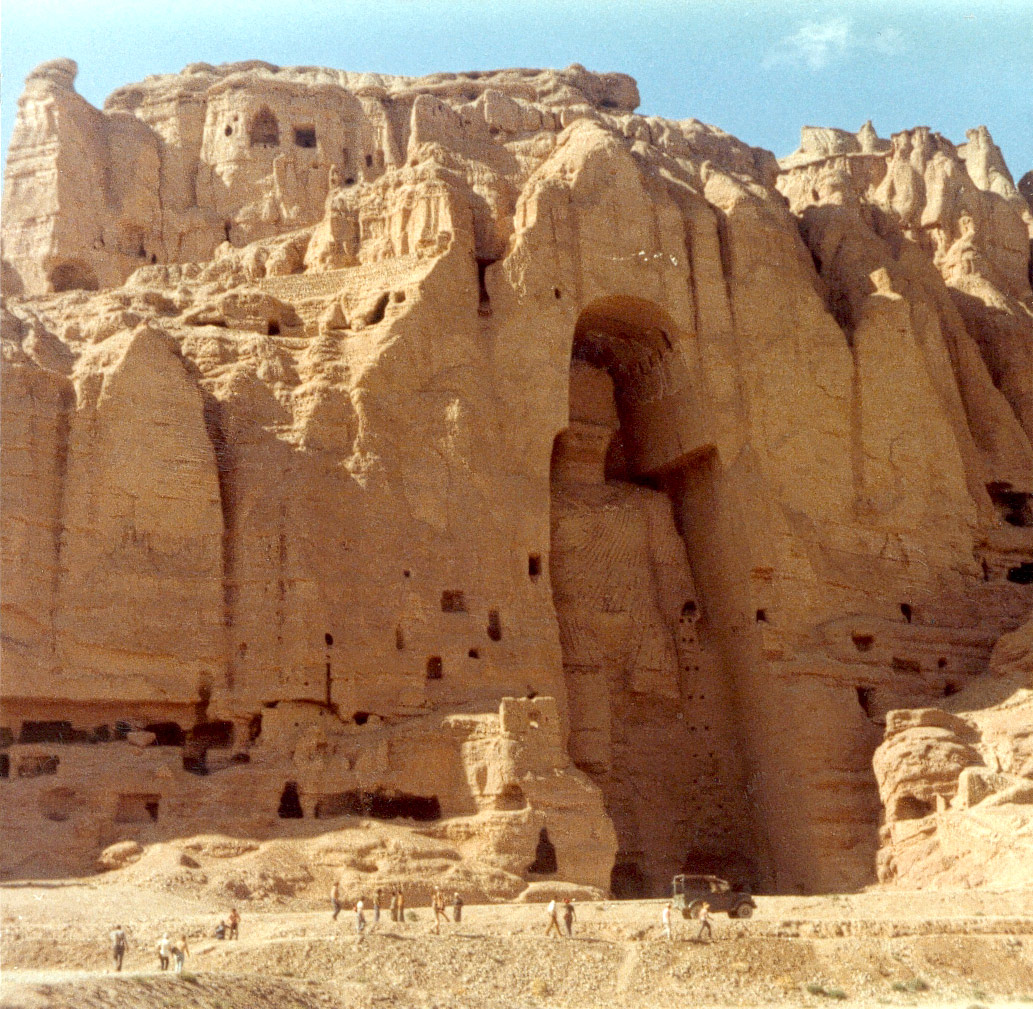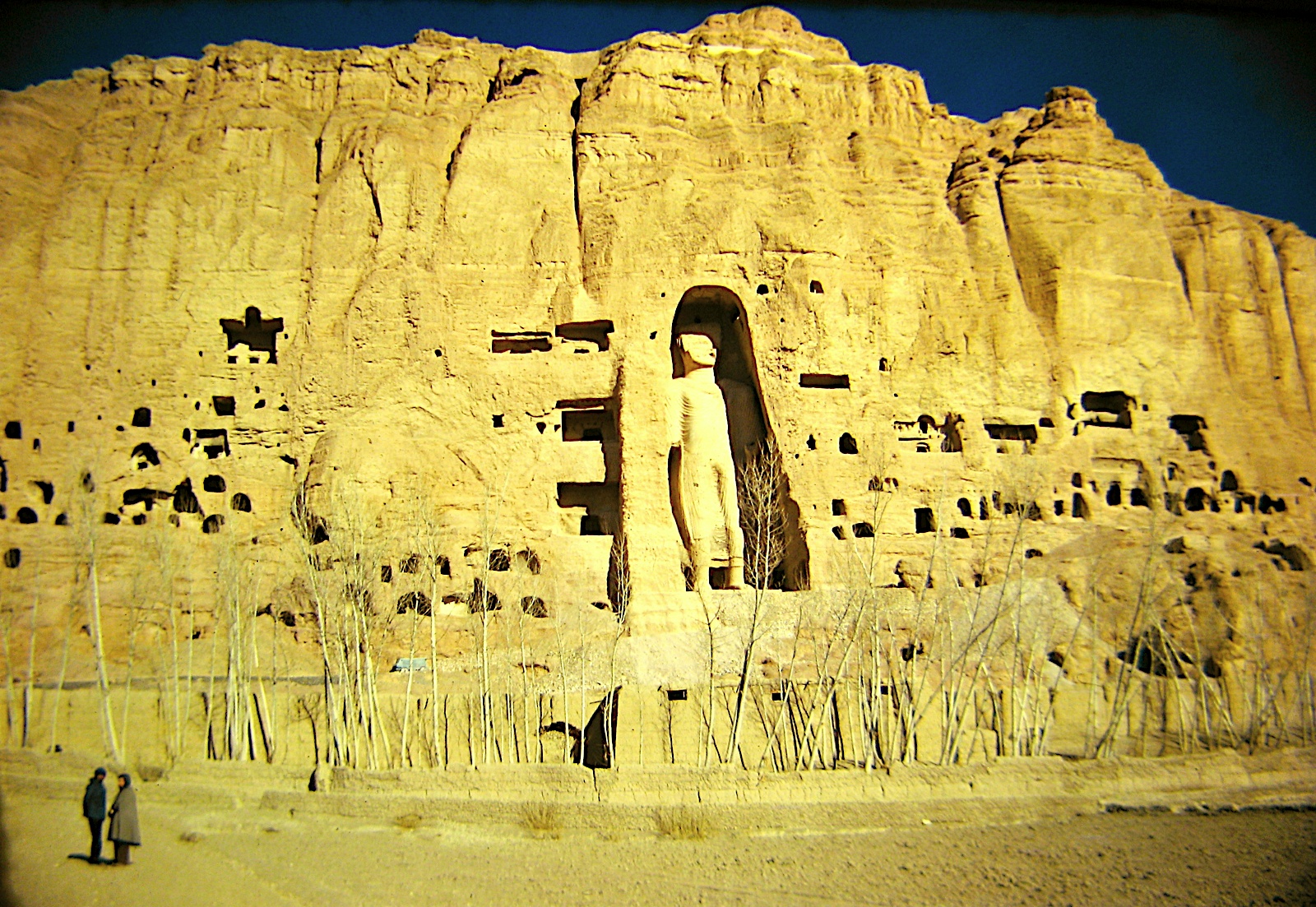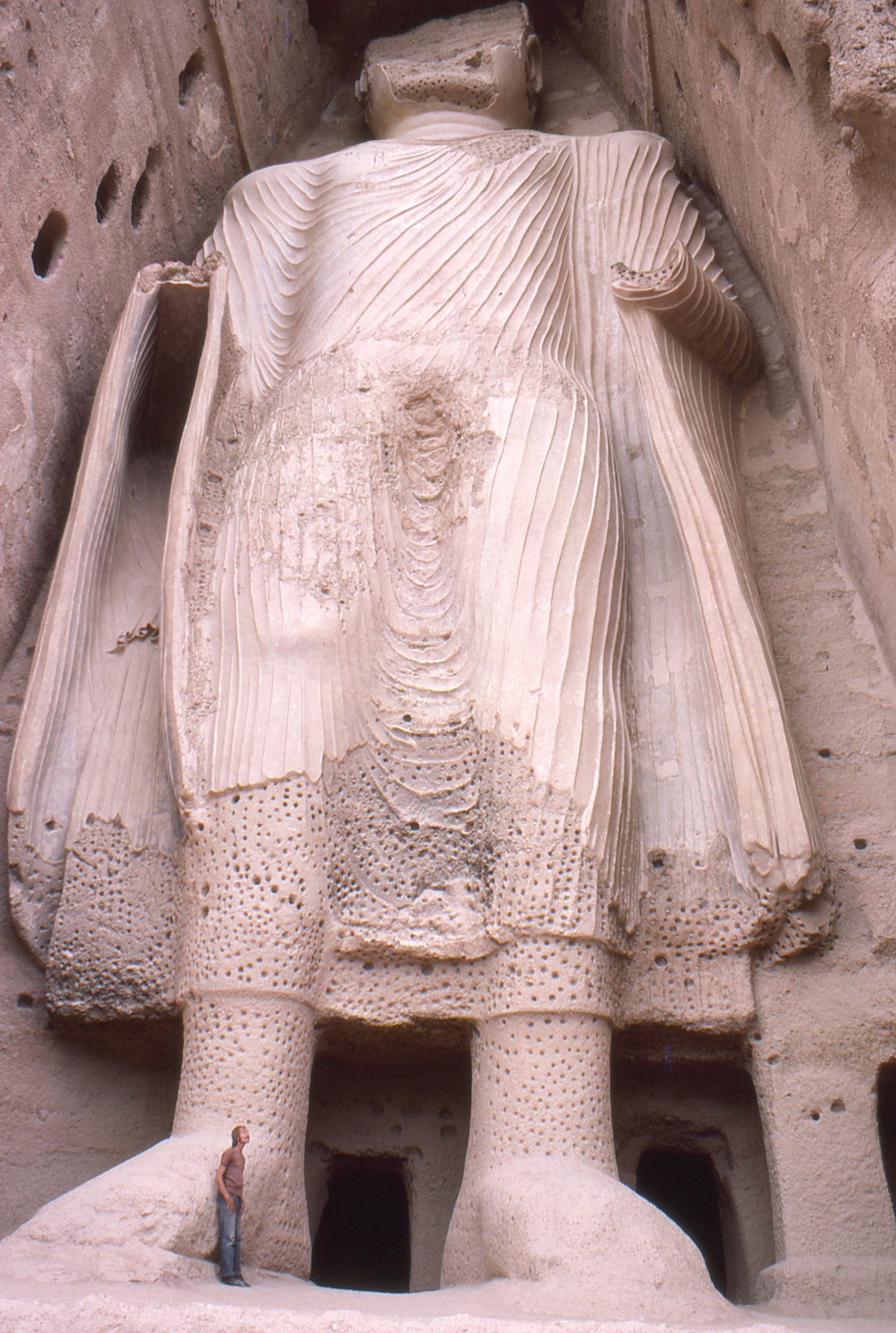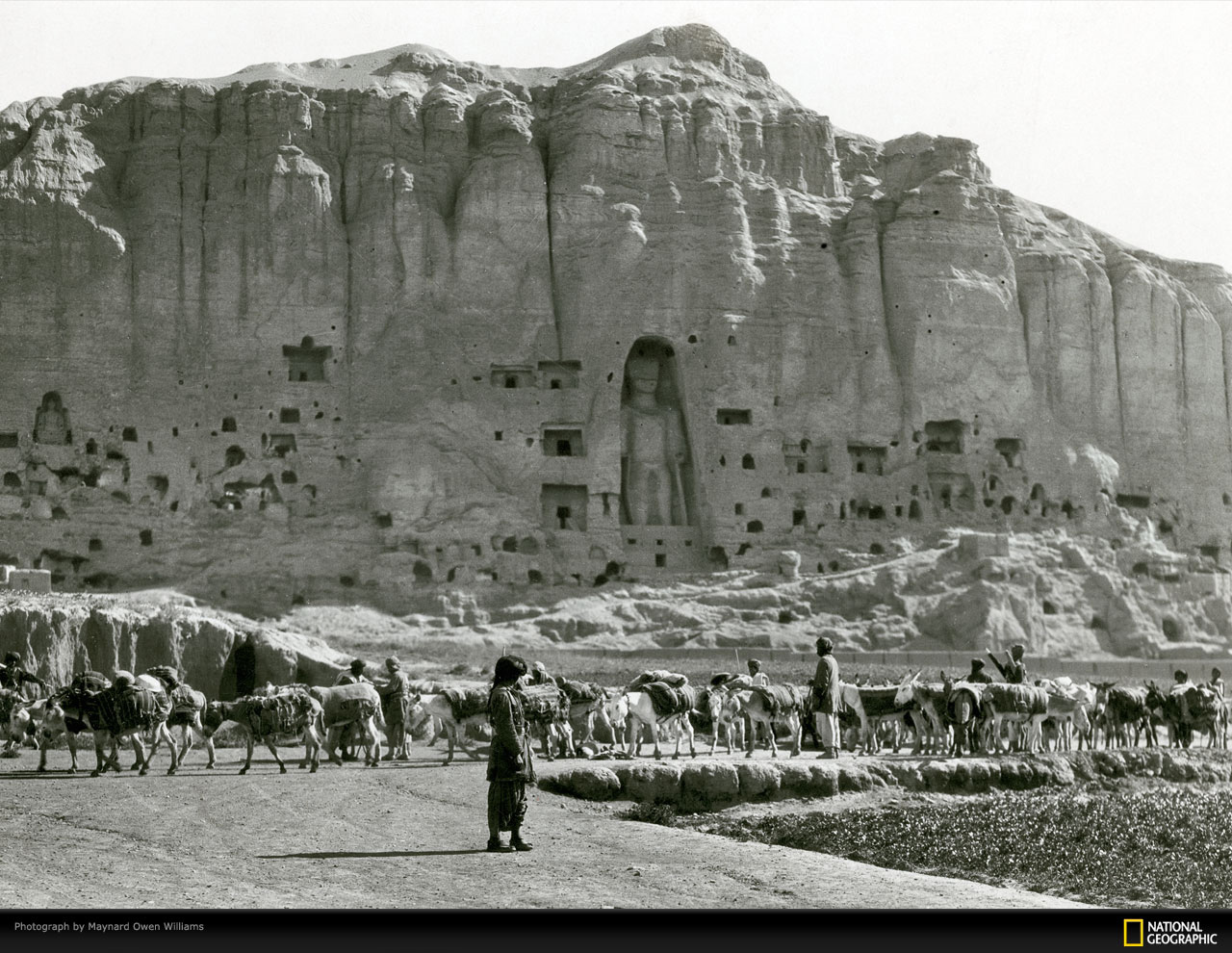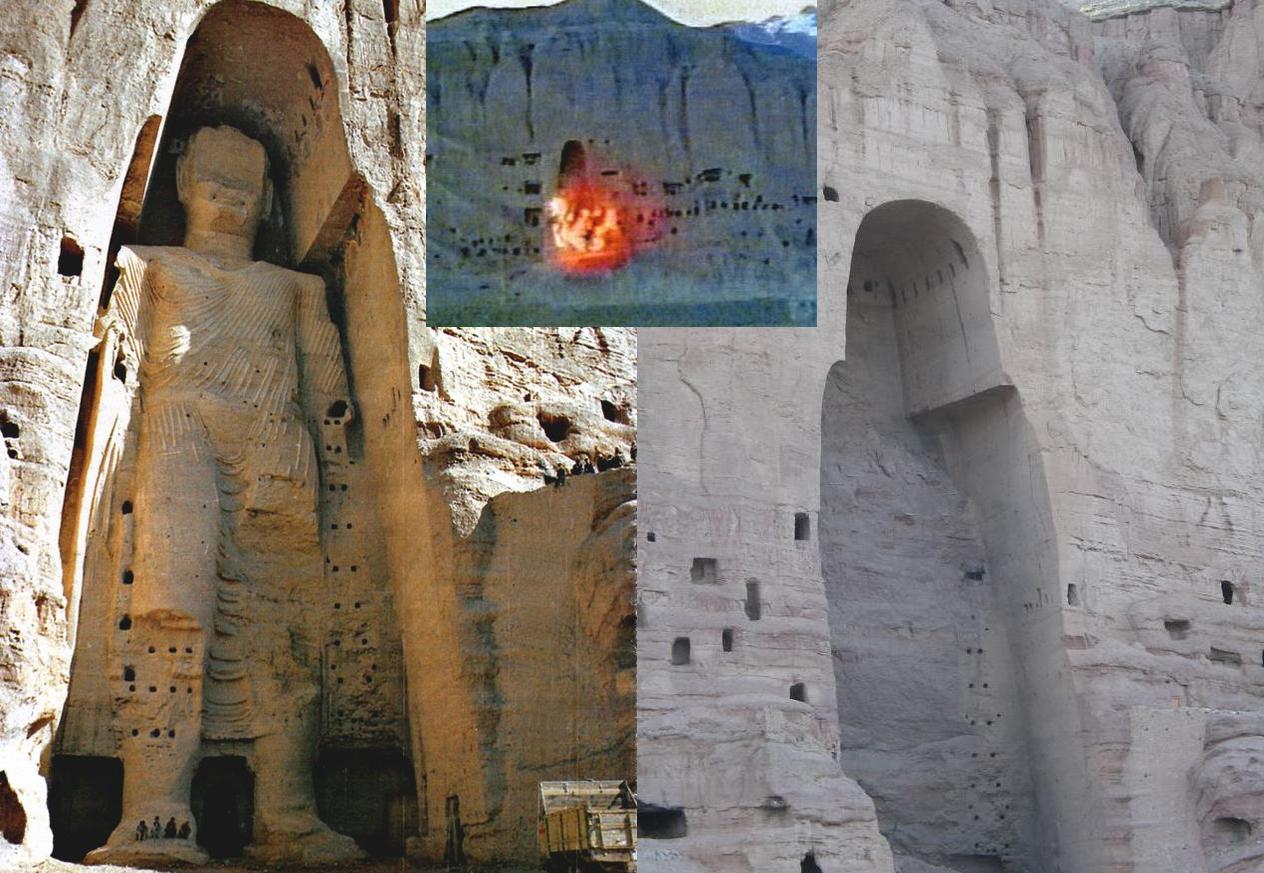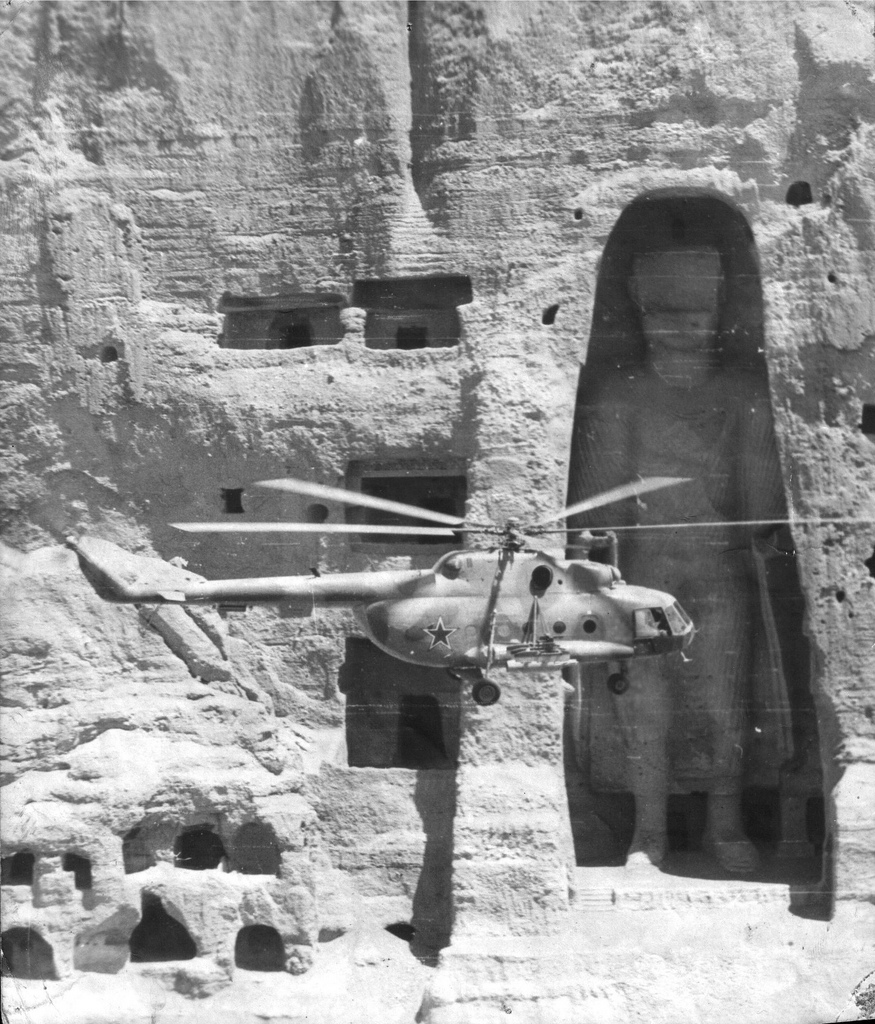The Buddhas of Bamiyan were two 6th-century monumental statues of standing buddha carved into the side of a cliff in the Bamyan valley in the Hazarajat region of central Afghanistan, 230 km (140 mi) northwest of Kabul at an altitude of 2,500 meters (8,200 feet). Built in 507 AD (smaller) and 554 AD (larger), the statues represented the classic blended style of Gandhara art.
The main bodies were hewn directly from the sandstone cliffs, but details were modeled in mud mixed with straw, coated with stucco. This coating, practically all of which wore away long ago, was painted to enhance the expressions of the faces, hands, and folds of the robes; the larger one was painted carmine red and the smaller one was painted multiple colors.
The lower parts of the statues' arms were constructed from the same mud-straw mix while supported on wooden armatures. It is believed that the upper parts of their faces were made from great wooden masks or casts. Rows of holes that can be seen in photographs were spaces that held wooden pegs that stabilized the outer stucco.
They were dynamited and destroyed in March 2001 by the Taliban, on orders from leader Mullah Mohammed Omar, after the Taliban government declared that they were idols. An envoy visiting the United States in the following weeks explained that they were destroyed to protest international aid exclusively reserved for statue maintenance while Afghanistan was experiencing famine, while the Afghan Foreign Minister claimed that the destruction was merely about carrying out Islamic religious iconoclasm. International opinion strongly condemned the destruction of the Buddhas, which in the following years was primarily viewed as an example of the extreme religious intolerance of the Taliban. Japan and Switzerland, among others, have pledged support for the rebuilding of the statues.
Bamiyan lies on the Silk Road, which runs through the Hindu Kush mountain region, in the Bamiyan Valley. The Silk Road has been historically a caravan route linking the markets of China with those of the Western world. It was the site of several Buddhist monasteries, and a thriving center for religion, philosophy, and art. Monks at the monasteries lived as hermits in small caves carved into the side of the Bamiyan cliffs. Most of these monks embellished their caves with religious statuary and elaborate, brightly colored frescoes. It was a Buddhist religious site from the 2nd century up to the time of the Islamic invasion in the later half of the 7th century. Until it was completely conquered by the Muslim Saffarids in the 9th century, Bamiyan shared the culture of Gandhara.
The two most prominent statues were the giant standing Buddhas Vairocana and Sakyamuni, identified by the different mudras performed. The Buddha popularly called "Solsol" measures 53 meters tall, and "Shahmama" 35 meters—the niches in which the figures stand are 58 and 38 meters from bottom to top. Before being blown up in 2001 they were the largest examples of standing Buddha carvings in the world (the 8th century Leshan Giant Buddha is taller, but the statue is sitting). Since then the Spring Temple Buddha has been built in China, and at 128 m (420 ft) it is the tallest statue in the world. Plans for the construction of the Spring Temple Buddha were announced soon after the blowing up of the Bamiyan Buddhas and China condemned the systematic destruction of the Buddhist heritage of Afghanistan.
The smaller of the statues was built between 544 and 595, the larger was built between 591 and 644. The larger figure was also said to portray Dīpankara Buddha. They were perhaps the most famous cultural landmarks of the region, and the site was listed by UNESCO as a World Heritage Site along with the surrounding cultural landscape and archaeological remains of the Bamiyan Valley. Their color faded through time.
Chinese Buddhist pilgrim Xuanzang visited the site on 30 April 630 AD, and described Bamiyan in the Da Tang Xiyu Ji as a flourishing Buddhist center "with more than ten monasteries and more than a thousand monks". He also noted that both Buddha figures were "decorated with gold and fine jewels" (Wriggins, 1995). Intriguingly, Xuanzang mentions a third, even larger, reclining statue of the Buddha. A monumental seated Buddha, similar in style to those at Bamiyan, still exists in the Bingling Temple caves in China's Gansu province.
The destruction of the Bamyan Buddhas became a symbol of oppression and a rallying point for the freedom of religious expression. Despite the fact that most Afghans are now Muslim, they too had embraced their past and many were appalled by the destruction.
In 1221 with the advent of Genghis Khan "a terrible disaster befell Bamiyan", nevertheless, the statues were spared. Later, the Mughal emperor, Aurangzeb, tried to use heavy artillery to destroy the statues. Another attempt to destroy the Bamiyan statues was made by the 18th century Persian king Nader Afshar, directing cannon fire at them.
The enormous statues, the male Salsal ("light shines through the universe") and the (smaller) female Shamama ("Queen Mother"), as they were called by the locals, did not fail to fire the imagination of Islamic writers in centuries past. The larger statue reappears as the malevolent giant Salsal in medieval Turkish tales.
Afghan king Abdur Rahman Khan destroyed its face during a military campaign against the Shia Hazara rebellion. A Frenchman named Dureau had pictured it in 1847.
Abdul Wahed, a Taliban commander operating in the area, announced his intention to blow up the Buddhas in 1997 even before he had taken control of the valley. Once he was in control of Bamiyan in 1998, Wahed drilled holes in the Buddhas' heads for explosives. He was prevented from taking further action by the local governor and direct order of Mohammed Omar, although tyres were burnt on the head of the great Buddha. In July 1999, Mullah Mohammed Omar issued a decree in favor of the preservation of the Bamiyan Buddha statues. Because Afghanistan's Buddhist population no longer exists, so the statues are no longer worshipped, he added: "The government considers the Bamiyan statues as an example of a potential major source of income for Afghanistan from international visitors. The Taliban states that Bamiyan shall not be destroyed but protected."In early 2000, local Taliban authorities asked for UN assistance to rebuild drainage ditches around tops of the alcoves where the Buddhas were set.
However, Afghanistan's radical clerics began a campaign to crack down on "un-Islamic" segments of Afghan society. The Taliban soon banned all forms of imagery, music, and sports, including television, in accordance with what they considered a strict interpretation of Sharia.
In March 2001, the statues were destroyed by the Taliban of Mullah Omar following a decree issued by him. The Taliban supreme leader Mullah Omar explained why he ordered the statues to be destroyed in an interview:
I did not want to destroy the Bamiyan Buddha. In fact, some foreigners came to me and said they would like to conduct the repair work of the Bamiyan Buddha that had been slightly damaged due to rains. This shocked me. I thought, these callous people have no regard for thousands of living human beings -- the Afghans who are dying of hunger, but they are so concerned about non-living objects like the Buddha. This was extremely deplorable. That is why I ordered its destruction. Had they come for humanitarian work, I would have never ordered the Buddha's destruction.
Information and Culture Minister Qadratullah Jamal told Associated Press of a decision by 400 religious clerics from across Afghanistan declaring the Buddhist statues against the tenets of Islam. "They came out with a consensus that the statues were against Islam," said Jamal.
The statues were destroyed by dynamite over several weeks, starting on 2 March 2001, carried out in stages. Initially, the statues were fired at for several days using anti-aircraft guns and artillery. This caused severe damage, but did not obliterate them. During the destruction, Taliban Information Minister Qudratullah Jamal lamented that, "this work of destruction is not as simple as people might think. You can't knock down the statues by shelling as both are carved into a cliff; they are firmly attached to the mountain". Later, the Taliban placed anti-tank mines at the bottom of the niches, so that when fragments of rock broke off from artillery fire, the statues would receive additional destruction from particles that set off the mines. In the end, the Taliban lowered men down the cliff face and placed explosives into holes in the Buddhas.] After one of the explosions failed to completely obliterate the face of one of the Buddhas, a rocket was launched that left a hole in the remains of the stone head.
On 6 March 2001 The Times quoted Mullah Mohammed Omar as stating, "Muslims should be proud of smashing idols. It has given praise to Allah that we have destroyed them."During a 13 March interview for Japan's Mainichi Shimbun, Afghan Foreign Minister Wakil Ahmad Mutawakel stated that the destruction was anything but a retaliation against the international community for economic sanctions: "We are destroying the statues in accordance with Islamic law and it is purely a religious issue."
On 18 March, The New York Times reported that a Taliban envoy said the Islamic government made its decision in a rage after a foreign delegation offered money to preserve the ancient works. The report also added, however, that other reports "have said the religious leaders were debating the move for months, and ultimately decided that the statues were idolatrous and should be obliterated".
Then Taliban ambassador-at-large Sayed Rahmatullah Hashemi said that the destruction of the statues was carried out by the Head Council of Scholars after a Swedish monuments expert proposed to restore the statues' heads. Hashimi is reported as saying: "When the Afghan head council asked them to provide the money to feed the children instead of fixing the statues, they refused and said, 'No, the money is just for the statues, not for the children'. Herein, they made the decision to destroy the statues"; however, he did not comment on the claim that a foreign museum offered to "buy the Buddhist statues, the money from which could have been used to feed children".
The destruction of the Bamiyan Buddhas despite protests from the international community has been described by Michael Falser, a heritage expert at the Center for Transcultural Studies in Germany, as an attack by the Taliban against the globalising concept of "cultural heritage". The director general of the U.N. Educational, Scientific and Cultural Organization (UNESCO) Koichiro Matsuura called the destruction a "...crime against culture. It is abominable to witness the cold and calculated destruction of cultural properties which were the heritage of the Afghan people, and, indeed, of the whole of humanity."




